In the IT world, a legacy system refers to an IT system that is outdated—yet still in use by an organization.
Software or hardware inevitably goes out of date, which means that even today’s most cutting-edge IT tools will eventually become legacy systems.
There are a number of problems associated with using legacy systems:
- Poor security. Aside from the inherent security that comes with on-premises platforms, older systems often become more vulnerable over time. For one, newer technology becomes more sophisticated, while legacy systems’ security measures become more outdated. The most pressing security issue with legacy systems is authentication. These systems heavily rely on password-based authentication, which is easily breached. Passwordless authentication solutions are more secure and convenient, but adapting legacy systems to use them is time-consuming and costly. Another issue is that support for older systems tends to wane over time, which means that security vulnerabilities aren’t addressed.
- Poor integration. IT systems operate within digital ecosystems, and as time goes on, digital ecosystems change. Newer tools tend to offer less and less compatibility with older systems, and it is often necessary to spend more resources in order to integrate the old and the new systems.
- A lack of speed and agility. Poor integration and siloed operations decrease an organization’s ability to adopt new tools, create new processes, and make agile decisions—all of which are essential for survival in today’s fast-paced era.
- Increased maintenance costs. Like automobiles, legacy systems require more maintenance as they age. Also, much like automobiles, legacy systems depreciate in value. Since legacy systems can never adapt or evolve, they will only decrease in value, while adding liability and risk.
Over time, nearly every system becomes a legacy system, and although migration is an essential step, companies are still compelled to use legacy systems for a variety of reasons.
Why maintain a legacy system?
Legacy systems are unavoidable for a few reasons:
- Resistance to change. Resistance to change is common in the face of shifts from the norm—anything between technology adoption to organizational change. This often stems from fear or inertia and can make it difficult to move away from old, familiar technology.
- Inability to demonstrate ROI. Another driver of hesitancy, often with the newest technologies, is that it can be difficult to demonstrate ROI. Many business leaders are wary of investing in technology fads, which can cause them to wait until a particular tool or system has become mainstream. Waiting too long, however, only causes existing tools to age and become less relevant.
- Technical challenges. As older systems become less common, so too do those with the skills to work with those systems. This can only make it more difficult and costly to migrate your employees away from them.
- Disruption to productivity. The adoption of new technology requires acceptance on the part of the workforce, as well as employee training and support programs. If digital adoption efforts are not handled effectively, the disruptive shift can impact employee productivity and morale, which can affect software ROI.
- Migration cost. Although maintaining legacy systems can be costly, so too can migration. The cost of migrating may result in a higher ROI and lower ownership costs over time, but the upfront investments can be challenging for many organizations to stomach.
In short, companies often use legacy systems because they have no other choice. While every organization would likely love to stay on the cutting edge of technology, the costs of migrating would simply be too great in many cases.
Migrating beyond legacy systems
In the era of digital transformation, migrating to newer IT systems has become common and even mandatory for companies that want to continue participating in the digital economy.
Here are a few tips that can help overcome the challenges covered above:
Use integrated data platforms. In legacy systems, data is often scattered across multiple databases, which can make migration a logistical mess. To simplify both data-driven business processes and the migration away from legacy systems, it is a good idea to invest in solutions that integrate data from multiple sources.
Examples include customer data platforms, which unify customer data into a single repository, or unified data platforms, which combine, store, and analyze data from across an organization.
Take a structured approach to change management. The technical side of organizational change often overshadows the people side of change, but employee support is necessary to drive any change forward, including the adoption of new IT systems.
Change management addresses the human side of change by developing strategies for communication, training, embedding new processes, and more.
Incorporate digital adoption into the business. Digital adoption refers to the state in which users gain the ability to use software for their intended purpose and to their fullest extent.
Having a structured, involved digital adoption program in the business can simplify software onboarding, training, and support. The results can include decreased employee resistance, streamlined IT adoption, and better outcomes for IT migration.
Take the leap of faith
Migrating beyond legacy systems to newer systems, such as cloud-based environments, can generate significant advantages and help organizations avoid many of the problems associated with legacy IT systems.
In fact, as-a-service models, such as those offered through cloud companies, often eliminate the need to maintain certain legacy systems altogether. Cloud-based tools, after all, can often be utilized across platforms and are updated automatically by vendors, minimizing the need for deployment or maintenance.




